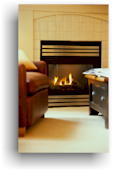|
|
||||||||

|
||||||||
| Heating | ||||||||
| For Your Home | ||||||||
|
|
||||||||
| Energy-Efficient Fireplaces | ||||||||
|
Dampers Flue Sealers Glass Door and Fireplace Covers Heat Exchangers Inserts Gas-Burning Fireplaces and Inserts Although wood-burning fireplaces have aesthetic appeal, they may actually remove more heat from a house than they produce. A typical, vertical-back fireplace with an open front is at best ten percent efficient in converting wood to energy and delivering it to a room. The rest of your wood dollars escape up the chimney. They also pull cold air into the house from small gaps around windows and doors. At the beginning and end of the burn, these convective heat losses are larger than the radiant heat provided by the fire. Also, most fireplaces are inappropriately situated on exterior walls. The large mass of masonry that makes up most fireplaces are poor thermal insulators and readily conduct room heat to the outdoors in cold weather. There are several types of accessories that modestly improve the heating efficiency of a traditional wood-burning fireplace. A fireplace insert, however, is the only add-on device that makes a significant difference. Dampers Flue Sealers
Most fireplace doors are made of tempered soda-lime glass. Tempered glass, often called safety glass, adds mechanical strength, making it more difficult to break than ordinary glass. If the glass does break, it shatters into many tiny pieces instead of large, dangerous shards. Fireplace doors should be kept clean. Glass that is darkened by soot and creosote reduces the radiant heat transfer to the room and may even weaken the glass during the extreme temperature changes of a fire. When shopping for fireplace doors, look for models with a rigid frame and a fiberglass seal that goes against the outside rim of the fireplace opening. The frame should fit securely, the doors should seal tightly, and the inlet vents should be adjustable. If you have a factory-built fireplace, find out whether the unit is approved for use with glass doors. Fireplace covers are less expensive than glass doors and also deter room air from escaping up the chimney. When installed correctly they seal off the fireplace opening once the fire has died out. To be effective, they need to fit tightly around the fireplace opening. Often a fiberglass gasket is used to aid in the seal that keeps room air in the building. Heat Exchangers Inserts Most inserts have tight-fitting glass or metal doors and built-in air circulation features. The most efficient models supply combustion air from outside the house. Virtually all of the inserts available are controlled-draft units, featuring manual or thermostatically controlled air inlets and gasketed doors. Some units are available with catalytic converters, which improve combustion efficiency. Combustion efficiencies for wood-fired inserts range from 63 % for non-catalytic inserts to 72 % for catalytic units. Pellet fueled appliances are about 80%. Gas units vary in heating efficiency, depending on whether they are vented or unvented. Fireplace inserts may have a single or a double wall. In single-wall units, room air is pulled in under the firebox and rises between the back of the unit and the masonry walls of the fireplace. This heated air then moves back into the room at the top of the insert. Double-wall units have an air space between the exterior and interior walls of the unit. Air circulates and heats in this space. This type is much more common, safer, and more efficient than single-wall inserts. Both types have separate combustion air inlets and either vent into the chimney or a chimney liner. Some inserts have fans to circulate air around the unit and blow heated air into the room. Fans may improve heat distribution (not combustion efficiency) by 50% to 75%. A fan may not be necessary if the unit is in a small room. In the past, an insert was often placed in the fireplace without any direct connection between it and the chimney. This method of installation led to an increase in creosote build-up, and a subsequent fire hazard, because the smoke lingered and cooled in the back of the fireplace instead of being immediately vented up the chimney. To prevent this, most building mechanical codes and the National Fire Protection Association (NFPA), require inserts to have a connector between the appliance outlet and the first section of the flue liner. Studies have shown that proper installation of fireplace inserts is very important. Have a professional installer examine the fireplace and chimney to determine if they are suitable for an insert. Inserts should be as airtight as possible. The more airtight it is, the easier it is to control the fire and the heat output. The installer should use only approved fireplace insulating materials to fill any gaps between the fireplace mouth and insert shield. Moving an insert to clean the chimney or liner can be difficult, and is a job best left to a professional chimney sweep. In some situations, a clean-out door can be installed above the insert connection so the insert does not have to be moved as often. Some models have wheels to simplify installation, cleaning, repairs, and other adjustments. Gas-Burning Fireplaces and Inserts Source: U.S. DOE, Energy Efficiency and Renewable Energy Network, Consumer Energy Information: EREC Reference Brief. EREC is operated by NCI Information Systems, Inc. for the National Renewable Energy Laboratory/U.S. Department of Energy. The content of this brief is based on information known to EREC at the time of preparation. No recommendation or endorsement of any non-U.S. Government product or service is implied if mentioned by EREC. | ||||||||
| ||||||||
|
||||||||
